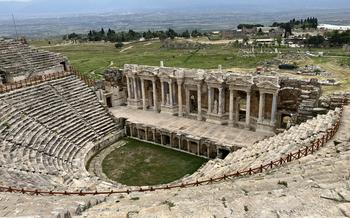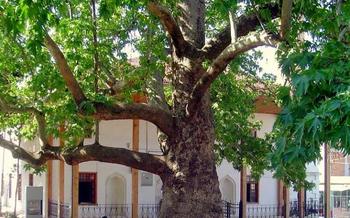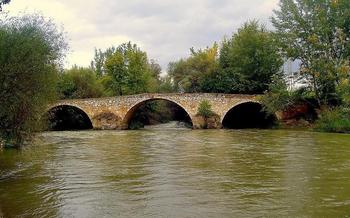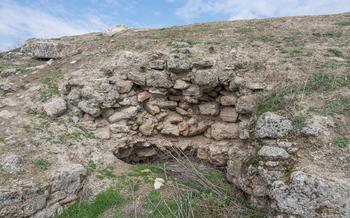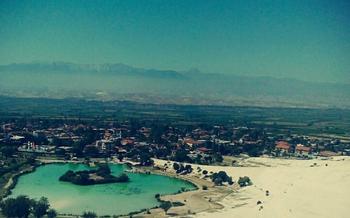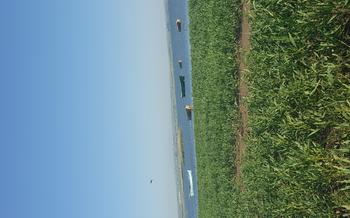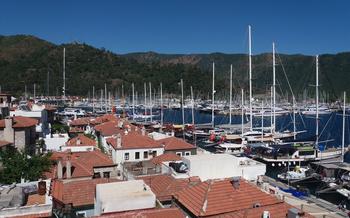
Crying Rock of Niobe
- Location and Accessibility
- Historical Significance
- Natural Beauty
- Visiting the Crying Rock
- Exploring Hierapolis:
- Pamukkale's Travertines: A Natural Wonder
- Thermal Springs and Spas
- Local Cuisine: Flavors of Denizli
- Handicrafts and Souvenirs
- Festivals and Events
- Accommodation Options
- Day Trips and Excursions
- Insider Tip: Unveiling Hidden Gems
Location and Accessibility
The Crying Rock of Niobe is situated in the Denizli province of Turkey, in the picturesque town of Pamukkale. This natural wonder lies within the boundaries of the ancient city of Hierapolis, a UNESCO World Heritage Site renowned for its well-preserved Roman ruins and thermal springs. The rock is easily accessible from major cities like Istanbul and Ankara, with direct flights to Denizli's Çardak Airport. From the airport, a short bus ride or taxi will take you to Pamukkale, where you can marvel at the awe-inspiring Crying Rock. Alternatively, you can opt for a scenic train journey from Istanbul to Denizli, offering breathtaking views of the Turkish countryside.
Historical Significance
The Crying Rock of Niobe holds significant historical value as a symbol of resilience and sorrow. It is closely associated with the Phrygian civilization, an ancient kingdom that flourished in Anatolia during the Bronze Age. The story of Niobe, a figure from Greek mythology, is deeply intertwined with the rock. According to legend, Niobe, the proud queen of Thebes, boasted of her seven sons and seven daughters, claiming they were superior to the children of the goddess Leto. This arrogance angered Leto, who sent her children, Apollo and Artemis, to slay Niobe's offspring. Witnessing the death of her children, Niobe wept incessantly, and her tears turned her into a stone statue that perpetually sheds tears, overlooking the Aegean Sea.
Archaeological excavations in the surrounding area have uncovered ancient ruins and artifacts that provide insights into the Phrygian civilization and its rich cultural heritage. These discoveries have shed light on the historical significance of the Crying Rock and its role in Phrygian mythology and religious beliefs.
Natural Beauty
The Crying Rock of Niobe is not only a symbol of myth and history but also a natural wonder that draws visitors from around the world. The rock formations that surround it, along with the Aegean Sea stretching out in the distance, create a breathtaking panorama that will take your breath away. The unique geological features of the area, including the travertine terraces and the mineral springs, add to the allure of the Crying Rock. These natural formations, created by the deposition of calcium carbonate from the hot spring waters, are a sight to behold. Visitors can take a leisurely hike or nature walk through the area, admiring the beauty of the landscape and taking in the fresh air. There are also plenty of opportunities for picnics and relaxation, as you can find a secluded spot and soak up the tranquility of this natural haven.
Visiting the Crying Rock
To visit the Crying Rock of Niobe, it is essential to plan your trip accordingly. The rock is situated in a serene and tranquil setting, and it is recommended to visit during the early morning or late afternoon when the lighting is most favorable for capturing stunning photographs. The rock is accessible throughout the day, and there is no admission fee.
When visiting the Crying Rock, remember to wear comfortable shoes as the terrain can be uneven and rocky. Additionally, bring a camera to capture the breathtaking views and the unique rock formation. Take some time to sit and appreciate the tranquility of the surroundings, and let your imagination transport you back to the time of Niobe's tragic fate.
Exploring Hierapolis:
A Step Back in Time to the Ancient City of Hierapolis
Just a short distance from the Crying Rock of Niobe lies the ancient city of Hierapolis, a UNESCO World Heritage Site that offers a glimpse into the glory of the Roman Empire. Step through the monumental North Gate and wander among the ruins of temples, baths, theaters, and other impressive structures. The highlights of Hierapolis include the well-preserved Roman baths, adorned with intricate mosaics and sculptures. The grand amphitheater, once the stage for gladiatorial contests, still stands as a testament to the city's grandeur. And don't miss the necropolis, an extensive cemetery filled with elaborate tombs and sarcophagi, offering a glimpse into the burial customs of the ancient world.
Pamukkale's Travertines: A Natural Wonder
Pamukkale, meaning "cotton castle" in Turkish, is a unique natural formation located in Denizli, Turkey. It consists of a series of cascading travertine terraces, formed by mineral-rich hot springs over thousands of years. The warm waters, rich in calcium carbonate, flow down the terraces, creating a dazzling white landscape that resembles a frozen waterfall.
The travertines of Pamukkale are a geological marvel and a UNESCO World Heritage Site. The terraces are composed of a soft, porous limestone called travertine, which is formed by the precipitation of calcium carbonate from the hot spring water. The water, which is slightly acidic, dissolves the limestone in the surrounding rock and then redeposits it as travertine when it reaches the surface.
Over time, the travertine deposits have built up to form a series of stepped terraces, each with its own pool of warm, mineral-rich water. The terraces are surrounded by lush vegetation, creating a stunning contrast between the white travertine and the green foliage.
Visitors to Pamukkale can walk along the travertine terraces and bathe in the warm, mineral-rich waters. The terraces are open to the public, and there are several designated bathing areas where visitors can relax and enjoy the therapeutic benefits of the thermal springs.
Thermal Springs and Spas
Denizli is renowned for its abundance of thermal springs and spas, offering a unique opportunity to experience the therapeutic benefits of mineral-rich waters. These springs have been celebrated since ancient times for their healing properties and are believed to have been used by the Romans, Byzantines, and Ottomans for bathing and relaxation.
Mineral-Rich Waters:
The thermal springs in Denizli are naturally heated by geothermal activity and contain a variety of minerals, including calcium, magnesium, and sulfur. These minerals are known for their therapeutic effects on the skin, muscles, and joints, and are believed to aid in the treatment of various ailments, such as rheumatism, arthritis, and stress-related conditions.
Spa Treatments and Therapies:
Numerous spas and wellness centers in Denizli offer a range of treatments and therapies that utilize the thermal waters. Visitors can indulge in relaxing massages, soothing mud baths, and rejuvenating body wraps, all while enjoying the therapeutic benefits of the mineral-rich waters.
Health and Well-being:
Bathing in the thermal springs is not only a delightful experience but also provides numerous health benefits. The warm, mineral-rich waters can help to improve circulation, reduce inflammation, and alleviate muscle pain. The minerals present in the water are also beneficial for skin health, promoting a radiant and youthful complexion.
A Relaxing Getaway:
Whether seeking relief from chronic pain, rejuvenation for the mind and body, or simply an escape from the stresses of daily life, the thermal springs and spas of Denizli offer a perfect sanctuary for relaxation and well-being.
Local Cuisine: Flavors of Denizli
Denizli offers a rich culinary experience, blending traditional Turkish flavors with local ingredients and influences. Savor the region's renowned cuisine, which showcases fresh produce, aromatic spices, and succulent meats. Indulge in mouthwatering kebabs grilled to perfection, tantalize your taste buds with yaprak sarma (stuffed vine leaves), and savor the hearty flavors of keşkek, a traditional wheat and meat dish.
Don't miss the opportunity to try Denizli's famous "thick soup," a hearty and flavorful dish made with chickpeas, lentils, and vegetables. For a taste of local bread, sample the delicious gözleme, a flatbread filled with various fillings such as cheese, spinach, or minced meat.
Local restaurants and eateries offer a warm and inviting atmosphere, allowing you to immerse yourself in the region's culinary culture. Engage with friendly locals and discover hidden culinary gems, savoring the unique flavors that make Denizli's cuisine unforgettable.
Handicrafts and Souvenirs
Denizli's vibrant markets and shops offer a treasure trove of handmade crafts and souvenirs that reflect the region's rich cultural heritage. Haggling is not only acceptable but expected, adding a touch of excitement to the shopping experience. Carpets, textiles, and ceramics are popular choices, each piece showcasing the skill and artistry of local artisans. Carpets, in particular, are renowned for their intricate designs and vibrant colors, often depicting traditional motifs and patterns. Hand-woven textiles, such as shawls, scarves, and tablecloths, are another must-have, featuring delicate embroidery and exquisite craftsmanship.
In addition to carpets and textiles, Denizli's markets offer a variety of ceramic items, from decorative plates and vases to intricate figurines and tiles. These ceramics are often adorned with colorful glazes and intricate patterns, making them unique and eye-catching souvenirs.
For those seeking a truly authentic experience, visiting the workshops of local artisans is highly recommended. Here, you can witness firsthand the creation of these beautiful handicrafts and gain insights into the techniques and traditions passed down through generations. Many artisans are happy to demonstrate their skills and share stories about their craft, making for a memorable and enriching experience.
Festivals and Events
Denizli comes alive with a vibrant array of festivals and events throughout the year, offering a glimpse into the region's rich cultural heritage and traditions. The annual Grape Harvest Festival, held in September, is a highlight, celebrating the region's renowned viticulture with grape stomping, wine tasting, and traditional music and dance.
In May, the Hierapolis Festival showcases the ancient city's history and legacy with reenactments, concerts, and exhibitions. The Denizli Rooster Festival, held in April, is a unique event showcasing the region's famous Denizli Rooster, a symbol of strength and resilience.
For those interested in traditional arts and crafts, the Denizli Handicraft Festival in November is a must-visit, featuring local artisans displaying their handmade creations, including carpets, textiles, and pottery. These festivals provide an opportunity to immerse oneself in the local culture, savor delicious Turkish cuisine, and create lasting memories.
Accommodation Options
Denizli offers a range of accommodation options to suit every budget and preference, from cozy guesthouses to luxurious hotels. For those seeking a truly immersive experience, consider booking a room with a view of the Crying Rock or the stunning Pamukkale travertines. Hotels like the Lycus River Hotel and the Pamukkale Thermal Hotel offer breathtaking vistas of the natural wonders, making your stay truly memorable.
To find the best deals and avoid disappointment, it's advisable to book your accommodation in advance, especially during peak tourist season. Online booking platforms and travel agents can assist you in comparing prices and securing the most suitable option for your needs. Whether you prefer a budget-friendly guesthouse or a lavish hotel with all the amenities, Denizli has something to offer every traveler.
Day Trips and Excursions
Extend your stay in Denizli and explore the surrounding region's rich tapestry of historical and natural wonders.
Embark on a day trip to the ancient city of Laodicea, a well-preserved archaeological site with impressive ruins, including a theater, stadium, and colonnaded streets. Immerse yourself in the history of this once-thriving metropolis.
Visit the nearby village of Goncalı, renowned for its traditional Turkish handicrafts, particularly its exquisite carpets and textiles. Witness the artisans at work in their workshops and take home a unique souvenir to cherish.
Discover the natural beauty of Salda Lake, a stunning crater lake with crystal-clear waters and a picturesque backdrop of mountains. Relax on its pristine shores, take a refreshing swim, and admire the diverse birdlife that calls this lake home.
Explore the ancient ruins of Aphrodisias, a city dedicated to the Greek goddess of love, Aphrodite. Marvel at the well-preserved temple, theater, and stadium, and admire the exquisite sculptures that have been unearthed here.
Venture into the Honaz Mountains, a breathtaking natural setting with lush forests, cascading waterfalls, and panoramic views. Hike through the scenic trails, encounter local flora and fauna, and find secluded spots for a peaceful picnic.
Insider Tip: Unveiling Hidden Gems
Beyond the well-known attractions, Denizli offers a treasure trove of hidden gems waiting to be discovered. For those seeking an authentic and off-the-beaten-path experience, venture into the picturesque villages nestled amidst the countryside. Engage with the friendly locals, savor traditional delicacies in family-run restaurants, and immerse yourself in the vibrant culture. Explore the ancient ruins and historical sites that dot the region, each holding untold stories of the past. Discover hidden waterfalls, secluded hot springs, and breathtaking panoramic viewpoints that will leave you spellbound. With a little exploration and curiosity, you'll uncover the true essence of Denizli and create memories that will last a lifetime.

